
Helastia mutabilis is a species of moth of the family Geometridae. It is endemic to New Zealand, where it is known from both the North and South Islands. It inhabits native forest at lower altitudes and its larval host are moss species in the genus Racomitrium. This species is nocturnal and is attracted to light. It can easily be confused with the similar in appearance species Helastia alba and Helastia cinerearia.

Asaphodes chlorocapna is a species of moth in the family Geometridae. This species is endemic to New Zealand and can only be found in the Chatham Islands. The larvae of this species consume the leaves of Muehlenbeckia plants. Adults are on the wing in January. This species is classified as "At Risk, Relict'" by the Department of Conservation.

Asaphodes oxyptera is a species of moth in the family Geometridae. This species is endemic to New Zealand and is only found in the Auckland Islands.

Asaphodes philpotti is a moth in the family Geometridae. It is endemic to New Zealand and has been found in the South Island as well as one observation in Wainuiomata in the North Island. This species inhabits native forest and larvae are hosted by species in the genera Hydrocotyle and Cardamine.

Asaphodes prasinias is a moth in the family Geometridae. It is endemic to New Zealand and has been found on both the North and South Islands. This species inhabits native forest including beech forest and subalpine scrub. The range of this species has reduced as this species is regarded as being locally extinct in the previously inhabited open non-forest habitats around Invercargill. Adults are on the wing from November to January.

Asaphodes recta is a moth in the family Geometridae. It is endemic to New Zealand and is found in the southern parts of the South Island. The preferred habitat of this species is open tussock grassland. The adults are on the wing in February and March. Larvae of this species have been reared on species in the genera Ranunculus and Bellis.

Asaphodes sericodes is a moth in the family Geometridae. It is endemic to New Zealand and has been observed in the southern parts of the South Island. This species inhabits open tussock grasslands in subalpine scrub or wetlands. The female of the species is likely semi-apterous and is flightless. The adult males are on the wing in January.
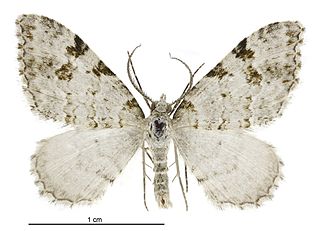
Helastia alba is a moth of the family Geometridae. This species is endemic to New Zealand and is found only in the South Island. This species inhabits native forest or scrubland and can be observed in montane to subalpine Nothofagus dominant forests. It has also been observed at lower altitudes in native podocarp forests. Larvae of this species have been raised on mosses. Adults are on the wing from November to January and are nocturnal. This species is very similar in appearance to other species in the genus Helastia, but specimens can be distinguished by the dissection of their genitalia.
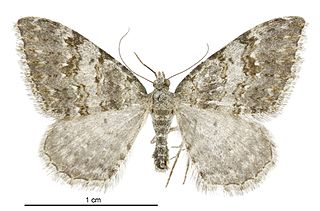
Helastia christinae is a moth of the family Geometridae. It was first described by Robin C. Craw in 1987. This species is endemic to New Zealand and has been confirmed as being observed at Dunedin, and the Central Otago and Otago Lakes areas. H. christinae inhabits subalpine to lowland areas frequenting river banks and stream sides. The food source for the larvae of this species are lichens. The adults of this species are on the wing in October to December. They are nocturnal and are attracted to light. Adult moths can be distinguished from similar appearing species in the genus Helastia as they have a "conspicuous transverse grey-ish white median band on the upper side of the forewing".
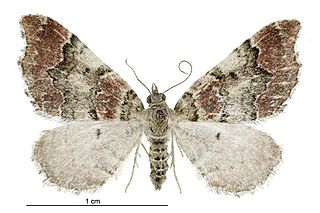
Helastia cryptica is a moth of the family Geometridae. It was first described by Robin C. Craw in 1987. This species is endemic to New Zealand and is found from mid Canterbury south. This preferred habitat of H. cryptica is native forest and scrub at altitudes ranging from lowland to subalpine. It has also been observed in human modified habitat. The larvae of this species has been observed on Melicytus alpinus, likely feeding on perched dead leaves and have been hypothesised as feeding on epiphytic mosses. Adults are nocturnal and are on the wing from November until January. Externally this species is indistinguishable from its close relative H. cymozeucta. However the distribution of these two species can assist in the correct identification of specimens.
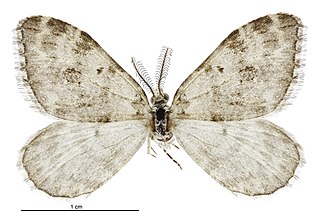
Helastia salmoni is a moth of the family Geometridae. This species is endemic to New Zealand and is found only in Fiordland in the South Island. Adults of this species are on the wing in January and are nocturnal and attracted to light. Although similar in appearance to Helastia corcularia, H. salmoni can be distinuished as its forewings are a lighter white-grey. This species was named in honour of John Salmon.
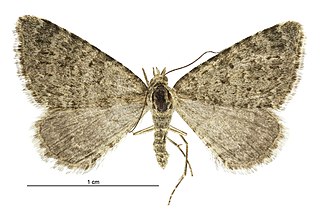
Helastia scissa is a moth of the family Geometridae. This species is endemic to New Zealand.
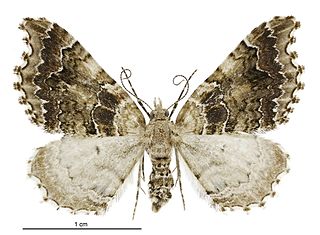
Helastia cymozeucta is a moth of the family Geometridae. It was first described by Edward Meyrick in 1913. This species is endemic to New Zealand and is found in both the North and the upper parts of the South Island. The adults of this species have been observed on the wing from November to January as well as in March.

Helastia farinata is a moth of the family Geometridae. It was first described by William Warren in 1896. This species is endemic to New Zealand and is found in the North Island. H. farinata inhabits shady and damp forest ravines.
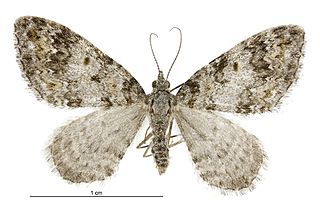
Helastia plumbea is a moth of the family Geometridae. This species is endemic to New Zealand and is found in both the North and South Islands. The species inhabits stream and river banks in montane to subalpine terrain. Adults are on the wing from October to April and are nocturnal and attracted to light. The life history of this species is, at 2024, poorly known but the larval host plants are likely mosses, herbs or possibly lichens.

Helastia semisignata is a moth of the family Geometridae. This species is endemic to New Zealand and is only found in the North Island. The life history of this species is in need of further investigation as sources differ about what plants host the larvae. Adults are on the wing commonly from October until March.

Helastia triphragma is a moth of the family Geometridae. This species is endemic to New Zealand. It was first described by Edward Meyrick in 1883 and originally named Cidaria triphragma.

Paranotoreas ferox is a species of moth in the family Geometridae. This species is endemic to New Zealand. This species was first described by Arthur Gardiner Butler in 1877 and named Fidonia ferox. In 1986 Robin C. Craw placed this species within the genus Paranotoreas.
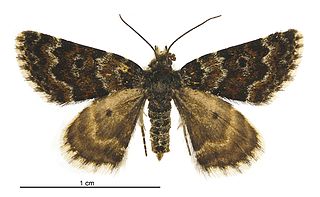
Paranotoreas opipara is a species of moth in the family Geometridae. This species is endemic to New Zealand. This species was first described by Alfred Philpott in 1915 and named Notoreas opipara. In 1986 Robin C. Craw placed this species within the genus Paranotoreas.

Xanthorhoe orophylloides is a moth of the family Geometridae. It was first described by George Hudson in 1909 and is endemic to New Zealand. This species is found in the subantarctic islands including at the Auckland Islands and at Campbell Island.




















